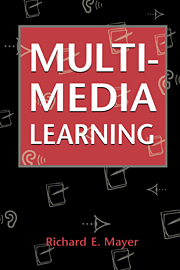Book contents
- Frontmatter
- Contents
- PREFACE
- 1 The Promise of Multimedia Learning
- 2 Multimedia Instructional Messages
- 3 A Cognitive Theory of Multimedia Learning
- 4 Multimedia Principle
- 5 Spatial Contiguity Principle
- 6 Temporal Contiguity Principle
- 7 Coherence Principle
- 8 Modality Principle
- 9 Redundancy Principle
- 10 Individual Differences Principle
- 11 Principles of Multimedia Design
- REFERENCES
- AUTHOR INDEX
- SUBJECT INDEX
9 - Redundancy Principle
- Frontmatter
- Contents
- PREFACE
- 1 The Promise of Multimedia Learning
- 2 Multimedia Instructional Messages
- 3 A Cognitive Theory of Multimedia Learning
- 4 Multimedia Principle
- 5 Spatial Contiguity Principle
- 6 Temporal Contiguity Principle
- 7 Coherence Principle
- 8 Modality Principle
- 9 Redundancy Principle
- 10 Individual Differences Principle
- 11 Principles of Multimedia Design
- REFERENCES
- AUTHOR INDEX
- SUBJECT INDEX
Summary
Redundancy Principle: Students learn better from animation and narration than from animation, narration, and text.
Theoretical Rationale: When pictures and words are both presented visually (i.e., as animation and text), the visual channel can become overloaded.
Empirical Rationale: In two of two tests, learners who received narration and animation performed better on tests of retention than did learners who received animation, narration, and text. In two of two tests, learners who received narration and animation performed better on tests of transfer than did learners who received animation, narration, and text.
INTRODUCTION
How Can We Improve Concise Narrated Animations?
Suppose there is a multimedia encyclopedia that contains entries based on the principles outlined so far in this book. For example, for each scientific explanation in the encyclopedia – such as how car brakes work, how the pumps work, or how lightning storms develop – the computer presents a short animation depicting the main steps in the process along with concurrent narration describing the main steps in the process. Thus, the multimedia explanations consist of concise narrated animations (or CNAs). Concise refers to a focus on the essential steps in the process; narrated refers to the words being presented as speech; and animations refers to the pictures being presented as an animation. The top of Figure 9.1 shows a selected frame from a concise narrated animation for lightning formation: As the animation segment containing this frame appears on the screen, the spoken words shown in the quotation marks come out of the speakers (or headphones).
- Type
- Chapter
- Information
- Multimedia Learning , pp. 147 - 160Publisher: Cambridge University PressPrint publication year: 2001



